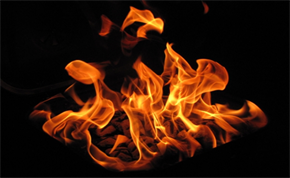
Globally, about 11 million people seek medical treatment, and 300,000 die, from burns each year.
And since January, our service has received more than 1,500 emergency 999 calls to people suffering from burns or explosion related injuries.
But how should we deal with burns?
About burns
Types of burns
Scalds: scald burns are very common in children – 85% of children that are admitted with burns have scald injuries and are under three years old. Most often caused by hot liquids, they can also frequently be seen in the elderly or those using drugs and alcohol, and are sometimes associated medical crises like hypoglycaemia or CVA.
Flame burns: these are seen mainly in patients from house fires, especially if their clothes have caught alight. Accelerants used to start bonfires or BBQs often lead to flame burns and may also be associated with airway burns.
Chemical burns: chemical burns commonly follow domestic and industrial accidents, but occasionally happen as a result of as self-harm or deliberate attacks. Specialist advice will need to be gained to deal with some situations.
Electrical burns: these may follow a low or high current source; low current characteristically produces a small deep burn at the entry and exit points with variable tissue damage between them. Depending on the anatomical path of conduction, there may be cardiac dysrhythmias.
Contact burns: result from skin contact with a hot object and depend on the nature and temperature of the heat source, and the length of contact.
Burn depths
The anatomical depth of a burn can be divided into:
Surface area may be assessed using the rule of nines in adults, adapted for children. The palm of the hand in adults (with the adducted fingers included) equates to approximately 1% body surface area. Do not include areas of erythema.
Factors contributing to poor outcomes
Assessment and management
Scene safety: Ensure the scene is safe for you and the patient. If safe to do so, remove the heat source and stop the burning process and remove hot and/or burnt clothing.
Start to prepare for cooling: Remove any constricting jewellery from the patient, and irrigate the burn with copious amounts of water (minimum of 15 minutes for chemical burns, and a maximum of 20 minutes for all other burns to avoid hypothermia) as soon as practicable. This can still be effective up to three hours after the injury. Alkali burns (some cooking oils) require prolonged irrigation continue to definitive care. Do not use ice or iced water.
Assess C – ABCDE:
Key points for the burns patient –
C - check for catastrophic haemorrhage.
A – airway patency as early intervention may be required with inhalation burns.
B – administer oxygen via a non-rebreathing mask. Sp02 readings may be false due to carboxyhaemoglobin. If patient is wheezing due to smoke inhalation, administer nebulised salbutamol.
C - fluid resuscitation if indicated.
D – assess the size of the burn, check limb perfusion and function distal to burn site.
E – check all areas, remove clothing (but remembering to consider hypothermia). Use small sheets of clingfilm (do not wrap the limb) as required and consider further pain relief options.
Documentation
Remember to record:
Further reading – AACE (JRCALC) clinical practice guidelines page 239-247.
Published 2nd November 2014